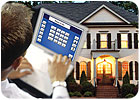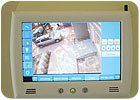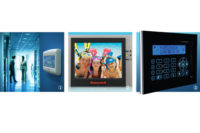
With Honeywell’s Internet Connection Module (ICM) product family, individual systems such as security or lighting are connected to separate ICMs, which communicate with each other over structured wiring or Ethernet.
In their pursuit of recurring monitoring revenues, some security dealers are accustomed to making little or no profit on home alarm installations. But it doesn’t always have to be that way.
One of the best ways to improve margins on home installations is to think beyond security. Integrating home security with home entertainment can add a level of convenience and even excitement that some customers are willing to pay for. By integrating their systems, end users can view a video surveillance camera aimed at an outside door on their television screen, hear customized music when they enter the home, and more. And with today’s increasingly sophisticated equipment, that type of system is easier than ever to install.
“When you look at the typical integrated home, security ends up being the cornerstone,” notes Tom Morgan, chief technical officer for Worthington Distribution, a Tafton, Penn.-based equipment distributor focused on home automation. “Nothing knows more about you than your security system. It knows when you’re home and when you’re away and how long you’re gone.”
As prices have come down, an integrated home security and home entertainment system has come within reach of more homeowners, adds Morgan — particularly those who are trading up after owning their first home for a number of years. “Before, integration was for corporate CEOs, entertainers and athletes,” he says. “Now it’s more mass market.”
To be successful with integrated home security and home entertainment systems, however, dealers have to change their mindset, Morgan cautions. “They have to move away from just a recurring revenue philosophy and view each installation as a profit opportunity.”

The K4 is a color LCD touch panel that provides a self-contained control system for controlling audio/video components, lights or other electronic systems in the home.
Video surveillance on the television set
Morgan and others interviewed for this article agree that one of the most appealing applications that integrates home security and entertainment is video surveillance. In its most basic form, this application entails connecting an analog camera via coaxial cable to a modulator, which in turn is connected to a television set. The modulator tunes the camera signal for viewing on a particular cable channel. This option has been around for many years, but increasingly, systems integrators are turning to more sophisticated solutions.By running a signal into a digital video recorder and then into the television, for example, home-owners gain the ability to record images from the video camera — and may even be able to use them as evidence in the event of a crime. As more and more homes become familiar with DVRs through offerings provided by satellite and cable companies, more and more end users are requesting this option. “We’re getting a lot of residential DVR business,” notes Morgan.
More homes today also have their own wired or wireless Ethernet networks, which in turn, are driving interest in cameras that use the Internet protocol (IP) for communication. IP cameras can easily be connected to modern television sets — and may have the additional advantage of remote control of pan-tilt-zoom functionality and remote viewing from a Web browser.
Newmarket, N.H.-based audio manufacturer Russound offers yet another option. The company offers a door station with a built-in camera that works with the company’s audio intercom system, which can play through the speakers of the homeowner’s audio entertainment system. When someone comes to the door, the doorbell can be heard throughout the home and the homeowner can see a video image of the person on video screens connected to the system.

GE Security offers a SmartCommand keypad for residential applications which is a multi-purpose keypad — eliminating the need for multiple keypads throughout the home.
Full integration
The most basic installations that enable surveillance video to be viewed on the television screen are essentially stand-alone systems and are not connected with intrusion protection or other systems in the home. But more advanced systems logically integrate home security with home entertainment and are part of a broader home automation system that can also control lighting, heating, air conditioning and more.Traditional home automation systems, such as those from high-end manufacturers Crestron of Rockleigh, N.J. and AMX of Richardson, Texas, become the master control for the entire home. Security and other systems may be connected to the home automation controller via an RS-232 connection. Alternatively, New Orleans-based manufacturer Home Automation Inc. (HAI) offers a less expensive panel that provides both home automation and security functionality.
Major security system manufacturers such as Melville, N.Y.-based Honeywell and Bradenton, Fla.-based GE also are getting into the game. At press time, GE was poised to launch its SmartCommand product platform, which uses structured wiring and can control intercom, audio, security, heating, air conditioning and lighting from a single hub. Honeywell offers similar functionality with its Internet Connection Module (ICM) product family, which uses a modular approach. Individual systems, such as security or lighting, are connected to separate ICMs, which communicate with each other over structured wiring or Ethernet.
Whichever home control solution a dealer chooses, a key role of the security system, beyond security, is to communicate users’ comings and goings to other elements of the system to trigger pre-programmed events.
By programming macros into an HAI system, for example, Morgan says customers can automatically have a certain audio source begin playing in certain areas of the home when a certain member of the family disarms the system. In the past, he notes, that type of functionality would have required custom code and a high-end controller.
Customers are impressed by customized audio applications that are triggered through a security system interface, agrees Stephen Merola, CEO of Futuristic Home Inc., a systems integrator with operations in Point Lookout, N.J. and Punta Gorda, Fla. “We always look for something with a lot of wow,” Merola says.
Merola traditionally has offered the HAI system, and is also looking at Honeywell’s offering for some installations. Merola likes the fact that such lower-cost systems are opening up home automation to a broader market. “We don’t have to have a high-priced programmer on staff,” he says.

When the front door bell rings and it is announced over the Nuvo audio system, the corresponding camera pops up on all the touch screens, and two way communications occur with Panasonic’s phone system.
A single interface
Another important capability of integrated home systems is the ability to control multiple systems, such as security and audio, from a single keypad or interface, which Merola likens to a “universal remote control for your whole house.”The single interface will become increasingly popular moving forward, predicts Bob Gartland, president of AVAD, a Van Nuys, Calif.-based home control equipment distributor. “The trend will be to replace security interfaces with a single interface that does security, audio, video, HVAC, lighting control and all of that,” he says.
Jim Paulson, global marketing leader for the GE Security Intrusion Group in Bradenton, Fla., uses the term “wall acne” to describe the single-purpose keypads that can proliferate in high-end homes. Builders and systems integrators love multi-purpose keypads because that approach eliminates “wall acne,” quips Paulson, who notes that a multi-purpose keypad is an important feature of SmartCommand.
Different manufacturers take different approaches to obtaining a single interface. Home Technology Systems Inc., Wichita, Kan. is one systems integrator that offers customers that option. “We can build templates with more graphics involved,” notes Shannon McGinnis, Home Technology Systems president and owner. “We can display a picture of the house that shows which doors are opened.”
Another approach is to select equipment from manufacturers that have developed interfaces to one another’s products. In that scenario, typically the keypad can display different templates, depending which system (heating, security, etc.) is selected. Some manufacturers, including Honeywell and DSC, support multi-purpose keypads and offer another option as well.
Honeywell’s solution relies on a graphical user interface that displays on a home computer. As Honeywell product manager Tim Trautman explains, “It finds the various technologies on the network — HVAC, security, lighting, or music and populates the user interface with a button for each module.”
If the computer used runs Microsoft Media Center or Vista software, the same home control system screens viewable on the home computer can also be viewed on a television screen connected to the system. Media Center or Vista computers typically come with a dedicated remote control which can be used to select items from an on-screen menu.
“The interaction between the person and the television is typically done through the remote control,” explains Trautman. “It allows you to sit on the couch and do everything from write an e-mail to select a movie. Video and music become selectable icons that you click on — and the security camera becomes a selectable option.”
DSC also has tapped Microsoft to help support a single interface solution. DSC offers an integration module that uses Microsoft’s Web Services for Devices (WSD) standard to interface with certain DSC control panels and Lifeware home automation software from Westerville, Ohio-based developer Exceptional Innovation.
“It allows for USB-like discovery of the security system on the home network and does not require complex programming,” notes Rob Guttentag, DSC vice president and general manager. “Dealers have full bi-directional control of the alarm system via the automation interface and, depending how the various automation software manufacturers have integrated security, they can emulate virtually any function you would have on a standard keypad from any connected TV or PC with media center extender.”
A similar result also can be achieved by using an RS-232 communication interface from DSC with any home control system with serial outputs, Guttentag explains.

Sales techniques
Systems that integrate security with home entertainment and automation are a natural fit for security dealers and systems integrators that install alarm systems for new homebuilders. Often the dealer or integrator will have the opportunity to meet with the purchaser and sell additional capabilities, including home control. And as Paulson notes, there can be a significant financial incentive for the homebuyer to purchase home control up front. When an integrated system is part of an initial home purchase, its cost can sometimes be rolled up into the mortgage, enabling the homeowner to pay for it over time for as little as $10 a month, he explains.The strongest hook for an integrated system typically is not home entertainment but lighting, notes McGinnis. He is most successful at selling integration when he asks customers, “Wouldn’t it be nice to open the door and have the lights automatically come on to light a pathway?”
When it comes to selling home control upgrades, Russound product manager Roger Soucy notes that security dealers and integrators often are better positioned than companies that focus on home entertainment installations. The reason, he says, is that customers purchasing home entertainment systems focus on the manufacturer’s name and reputation, while security purchasers focus on the installing company and often are not concerned about the manufacturer. And if new wiring is needed, he says, “Guys who do security can snake wires in places you’d never think possible.”
“They have the skill set and the client base,” Soucy adds. “This gives them the opportunity to increase revenue and offer more system convenience.”
